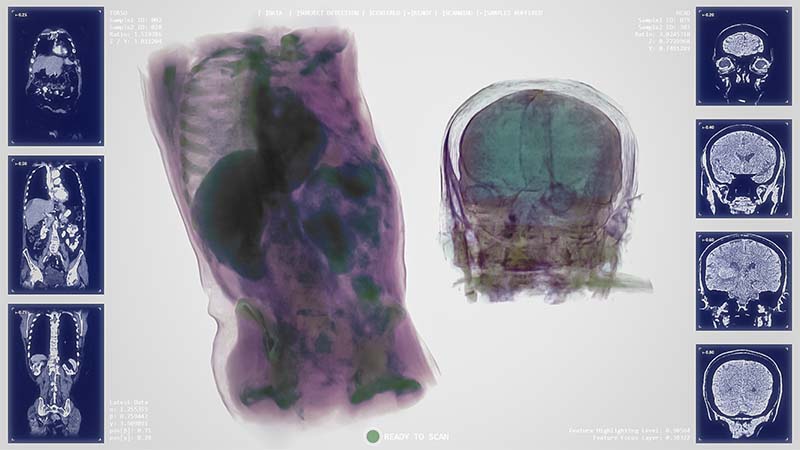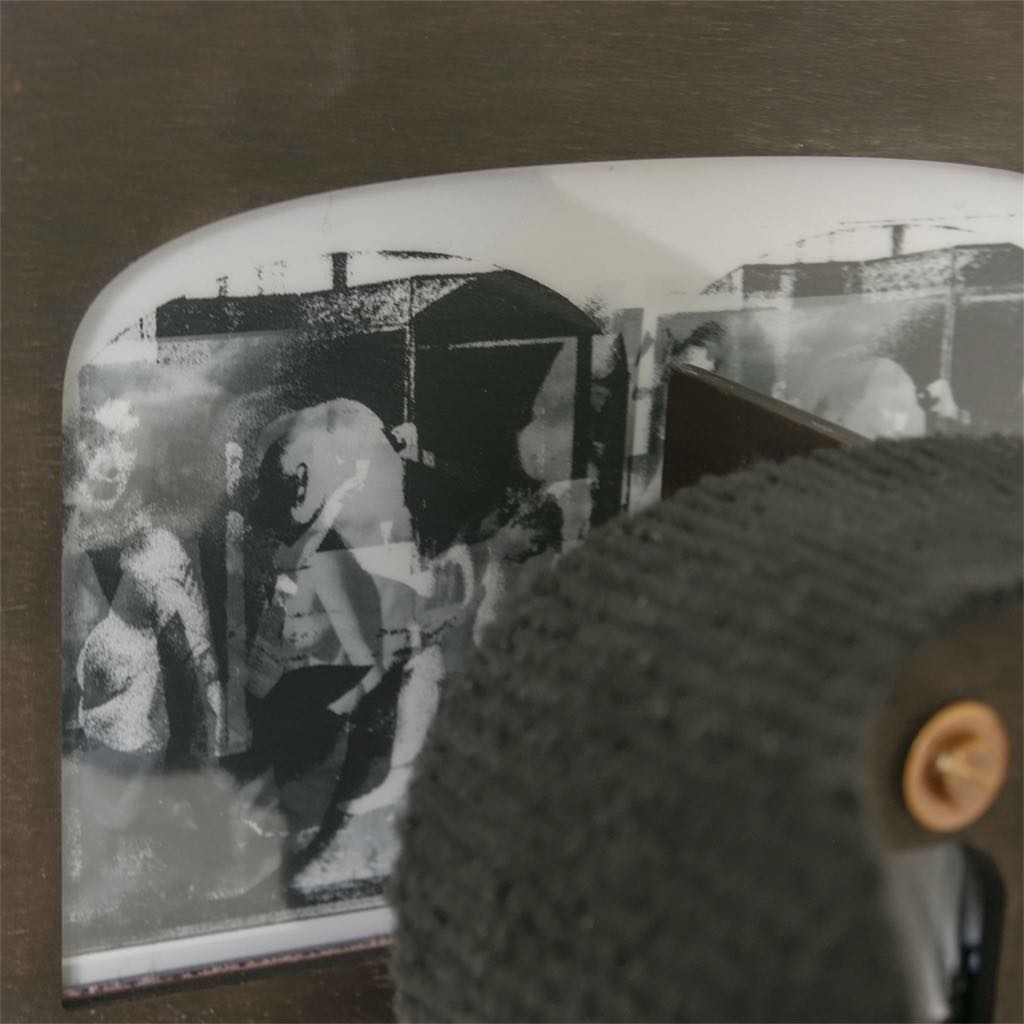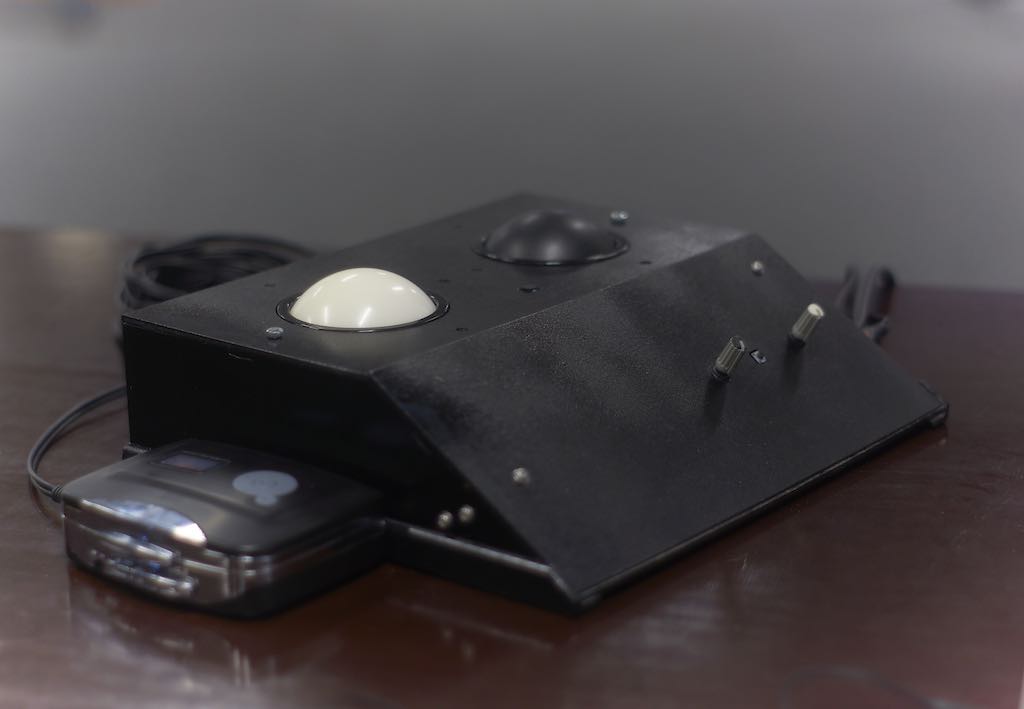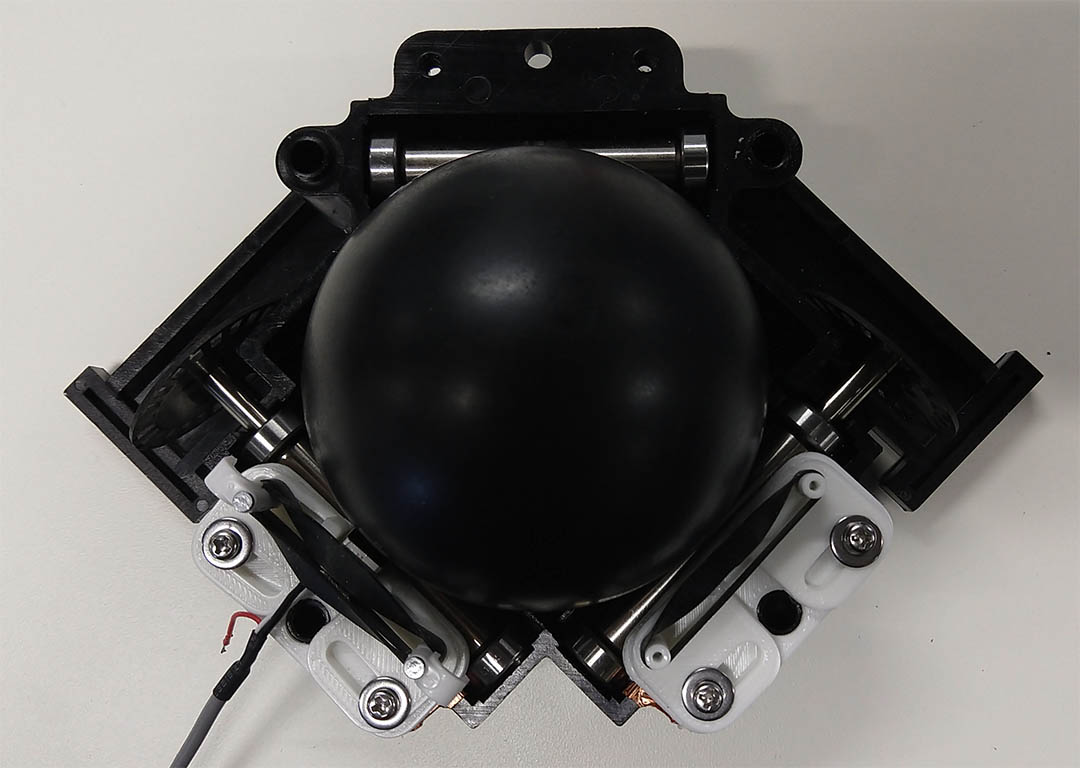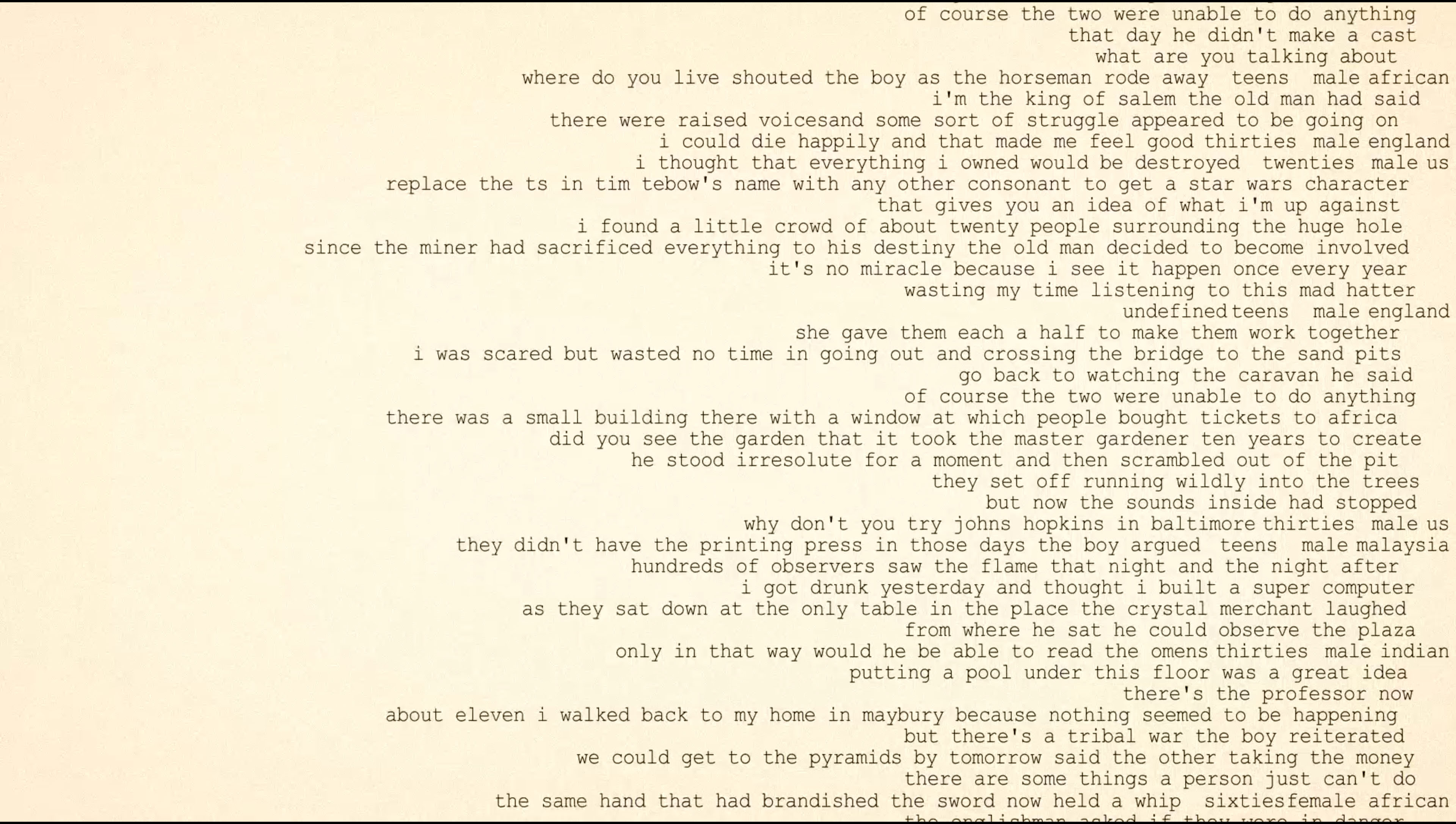Homodyne
through dance, sound and visual interpretations
About
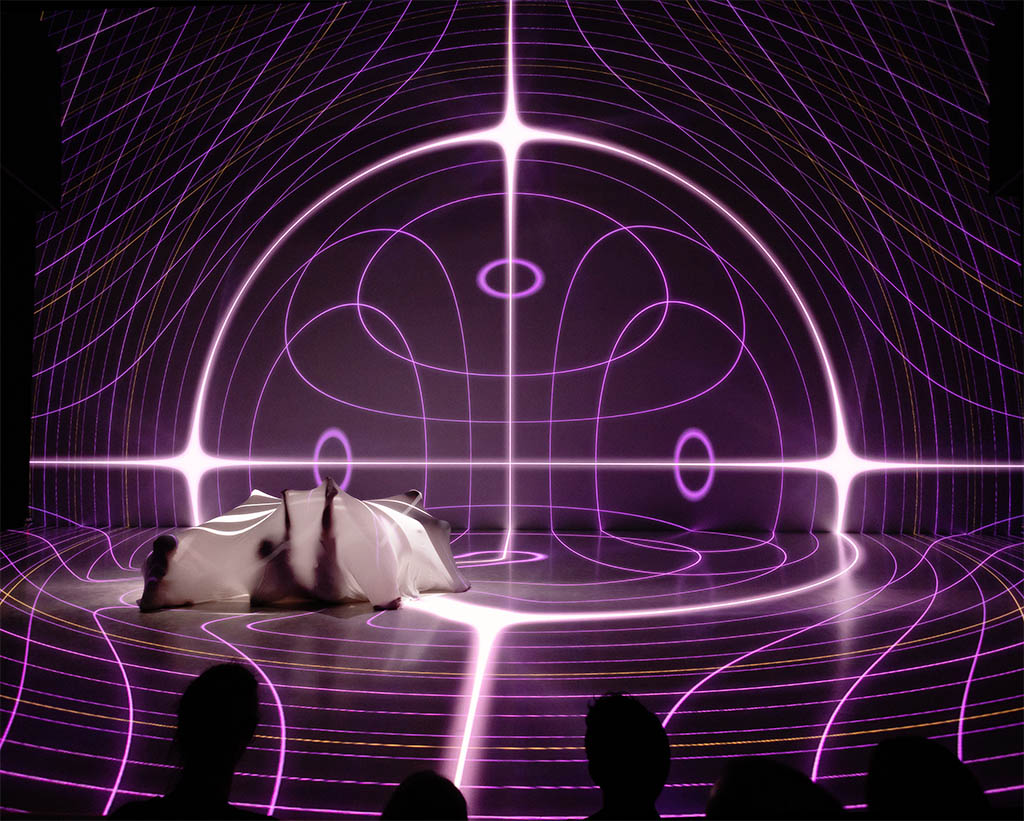
This work combines dance, imagery and sound to explore principles of the quantum world as a joint endeavour between The University of Arts and Design, Linz, Anton Bruckner Private University and the Institute for Quantum Optics and Quantum Information (IQOQI), Vienna. It exists as six movements that overlap in theme and design. To produce the visuals, I considered aspects including quantum uncertaintly, oscillation, wave particle duality, tuneling, gravity, spherical harmonics, simultaneity and symmetry. These are generated in concert between the Pharus tracking system and VVVV visual design software to produce content that both reacts and maps to the positions of the performers, while additionally reacting the the pre-composed audio.
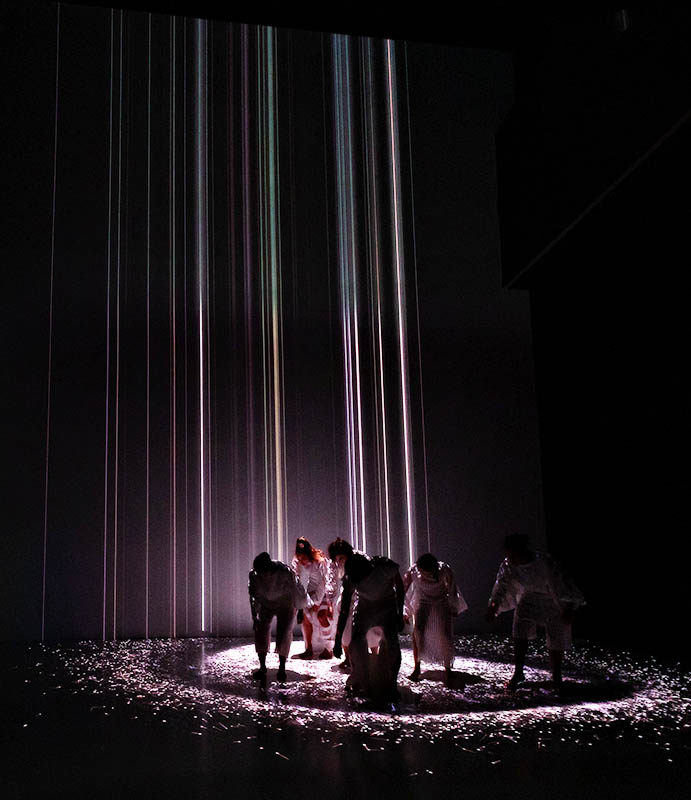
The musical score was composed with the sames concepts in mind, while drawing sonic elements from software based randomizers, brownian noise generators, crystal oscillators, and homodyne data provided by the researchers at the QISS lab of IQOQI. Melodic and harmonic elements structurally mirrored the visual design, while temporally following the choregraphies provided by the performers.
[soundtrack available on bandcamp]
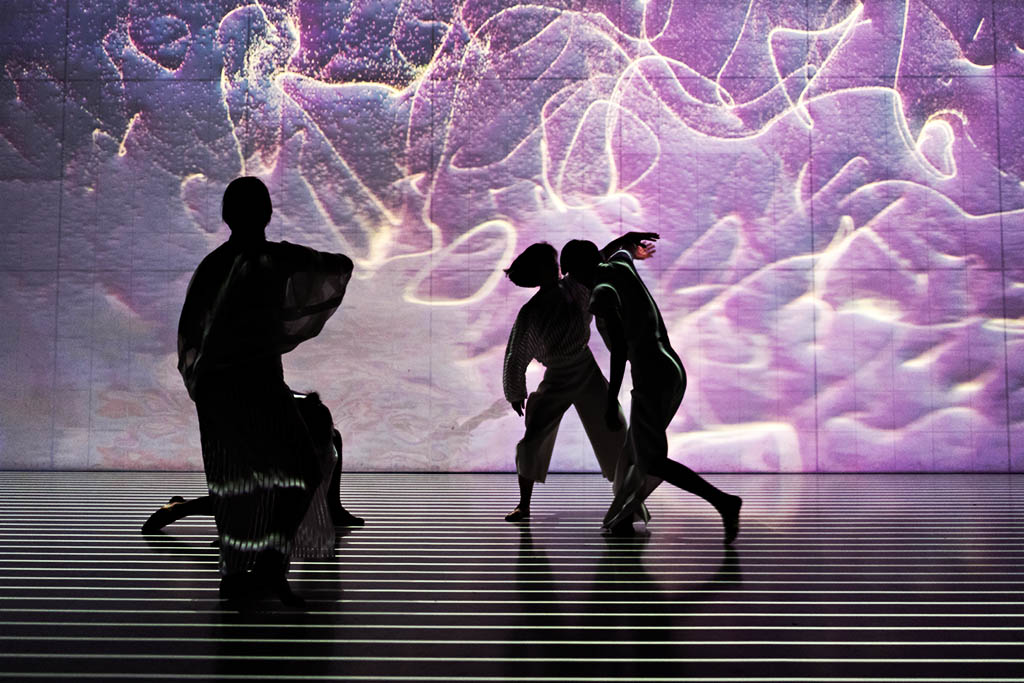
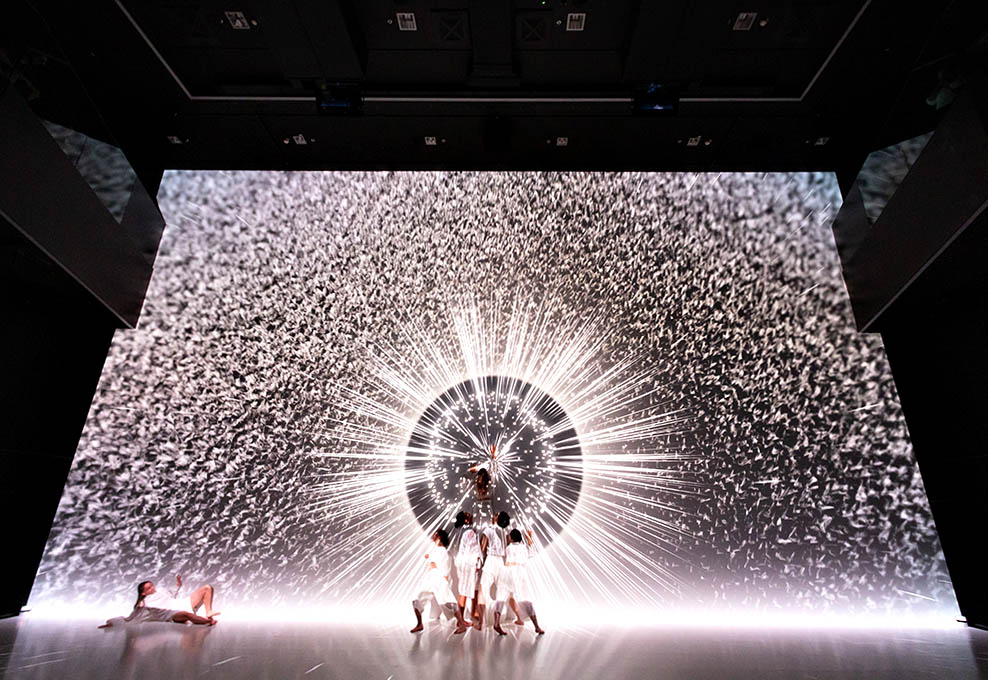
Preliminary Documentation by Linaá Pulido Barragán
CREDITS
Dance and Movement:
Erick AguirreJiaji Cheng
Danica Golic
Eunji Ji
Polina Kliuchnikova
Kateryna Pomeichuk
Visual Design
Kevin BlackistoneMusic Composition: (1st, 2nd & 4th - 6th Movements)
Kevin BlackistoneLive Composition (3rd Movement) and Triggered Audio:
Kathrine HardmanCostumes:
Julia MoserCurators Workshop „Embodied Ecologies 2023“:
Smirna KulenovicDamian Cortes Alberti.
Guest Lecturer:
Prof. Dr. Christodoulou Marios (QISS Vienna)Technical Support:
Otto Naderer
Performed
Produced for Kunstuniversität Linz Rundgang 2023 at Ars Electronica Center DeepSpace8k
Ars Electronica Festival, AT. 2023
Mapping Festival, CH. 2024
Hostile Architectures in Improvisation
Synopsis 1: Using music & performance as metaphor to explore the intrinsic societal complications imposed through unfettered use and cross-pollinations of hostile architecture and algorithmic control systems.
Synopsis 2: An exploration of algorithmic approaches to prevention of intentional habits, there-by forcing new personal approaches to musical performance.
Abstract:

Within the world of architecture, there is a term known as ‘hostile’ architecture. This refers to design intended to preventing individuals from utilizing a space outside of intended uses. Often this manifests as forms of physical elements that prevent uses such as comfortable rest for the homeless or community activations such as skating through various blocking elements. This adversarial approach is used as a means to train machine learning algorithms by providing a negative to prove the quality of a positive. Just as the communities around these hostile architectural designs find ways to move in and around them, thus do these algorithms find there way to a relative/desired truth. Software itself is also frequently defined as an architecture. This work seeks to explore ways in which an adversarial and directly hostile software/hardware design approach can be used in the shaping of performance to force or direct the performer into new patterns by preventing those common to that individual.

These topics are explored through a variety of
performance learning strategies: responsive, evolutionary, and compositions
Software architectures: Performance blocking, altering, anti-scoring and time-shifting
Physical interface production explorations
Performer interferences: Physical interference, electroshock
Input and learning data sources: Biological (emg), audio analysis
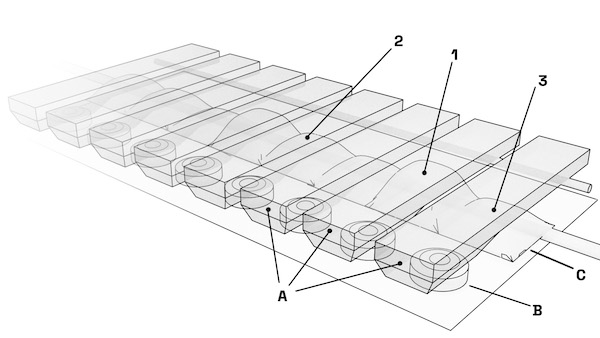

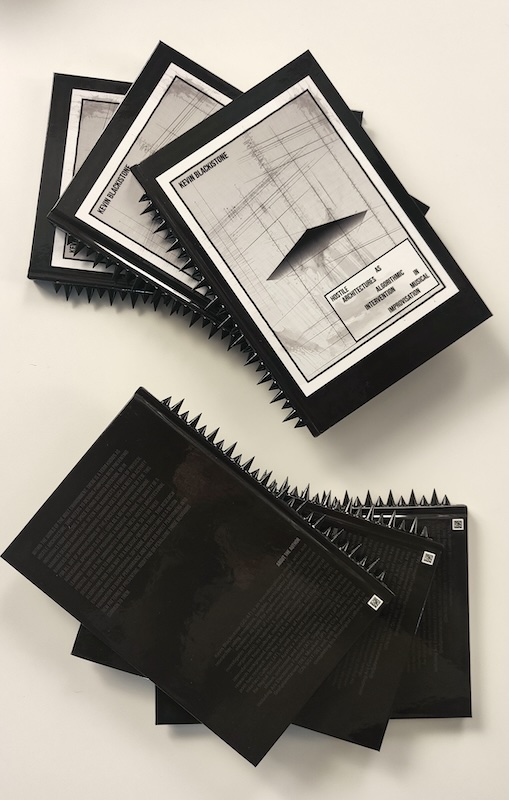
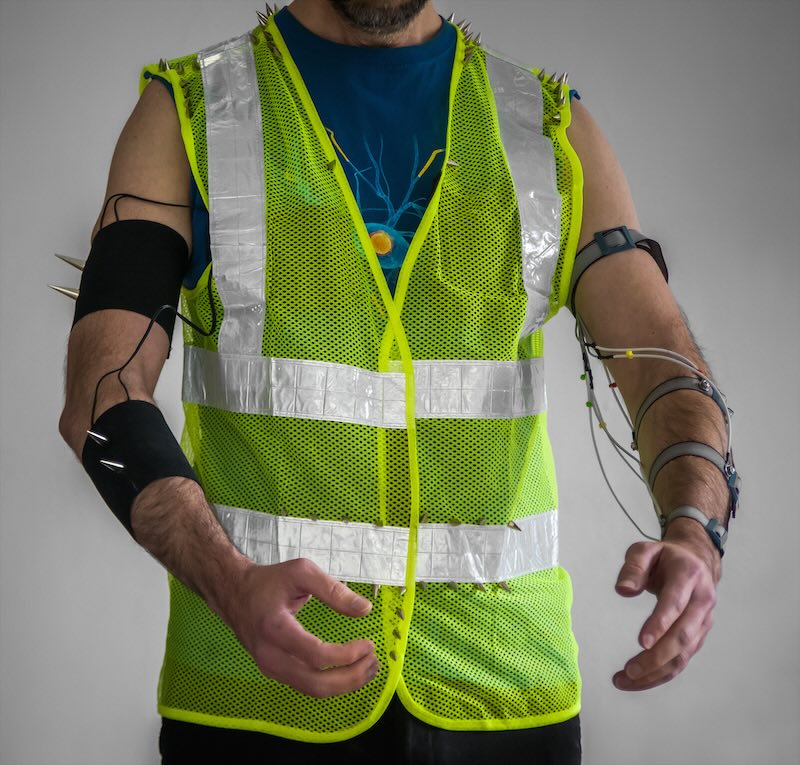

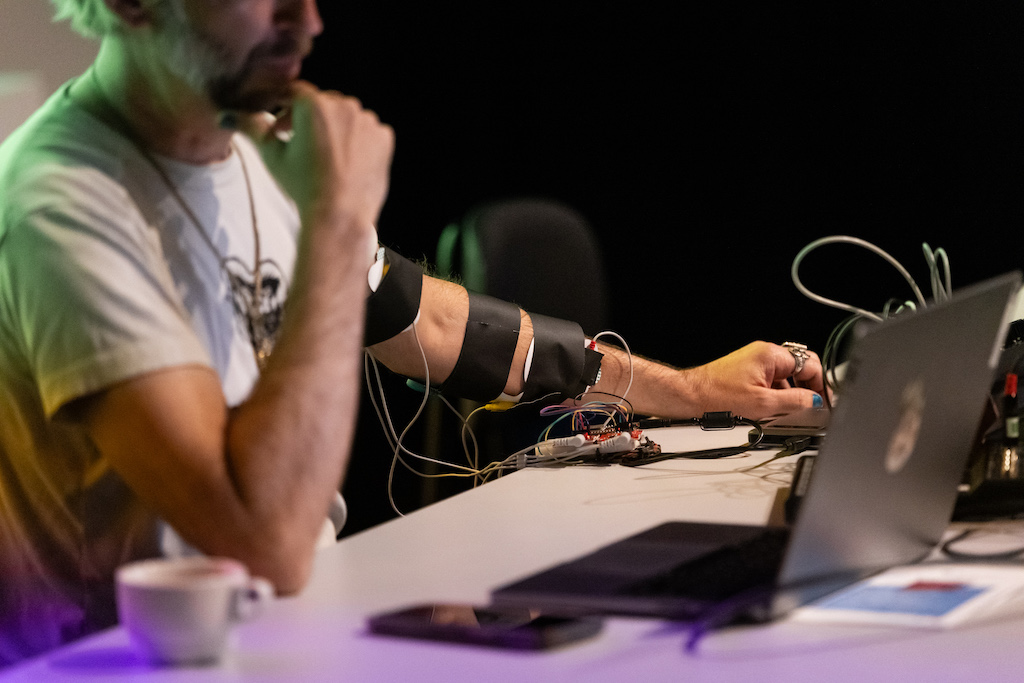
Photo from Sonic Saturday lecture performance by:
Bogi Nagy @bophotoadventures
Presented
International Computer Music Conference, Boston. 2025
Sonic Saturday, AT. 2024
Tangible Music Club, STWST, AT. 2024
Press
Watch the performance at STWST on Dorf TV
Interview with Kevin Blackistone and Martí Ruids on Radio Fro
Habitat
A brief animation which considers resource limitations on our planet.
Abstract:
As billionaires speak platitudes of the need for space colonization (often rehashing imagery from the later 20th century, without the study of what research and findings came out of those projects), it is worth considering that if we are unable to find a means to maintain ourselves on the resource-rich environment of earth on which we have evolved, then we are unlikely to long support ourselves in tightly controlled and resource-poor environments of space. Perhaps the self-sustaining ecosystems of terrariums and non-human species might be better suited to the task of exploration. Or perhaps this serves as a metaphor to demonstrate we exist in a global terrarium, with greater, but no less finite, resources.
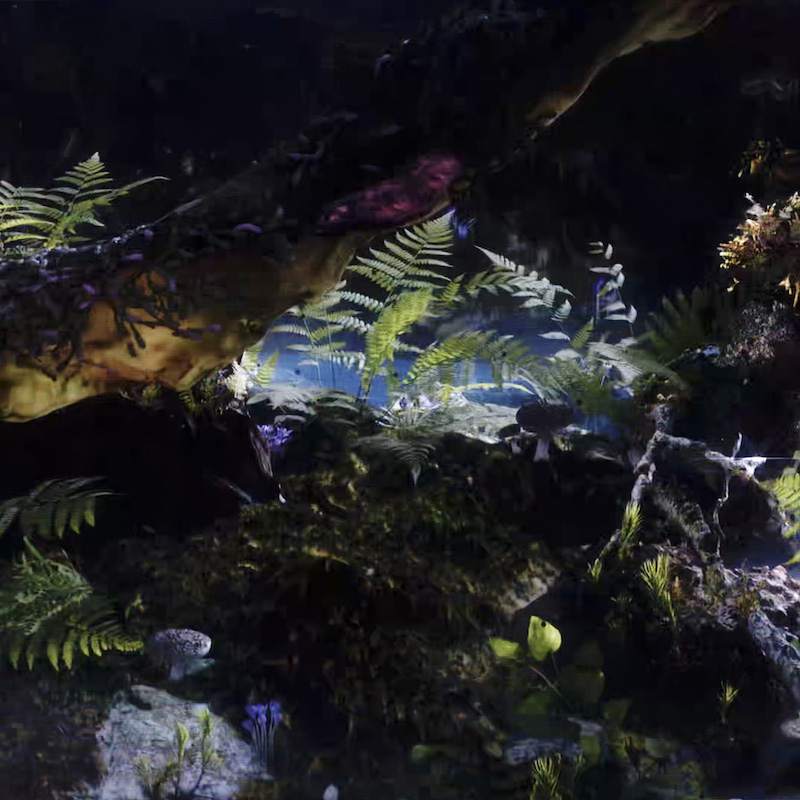



Award
City Digital Skin Art Bronze award 2024:
Exhibited
- Elbphilharmony, DE. 14-31 Oct
- Milan Central Station, IT. 10-14 Oct
- Ten Square, SG. 18.Oct
- Hangzhou FTU CC West Lake Canopy, CN. 22.Oct
Windows on Charles, US. 2024
Exquisite Corpus
ML blended radiology scans a multiple individuals as chimeric interior forms.
Exquisite Corpus, Corpora in 5 Forms. 2024
An expanding collection of interactive, generative and/or immersive artworks exploring the commonalities of the human organism through novel, blended radiology datasets
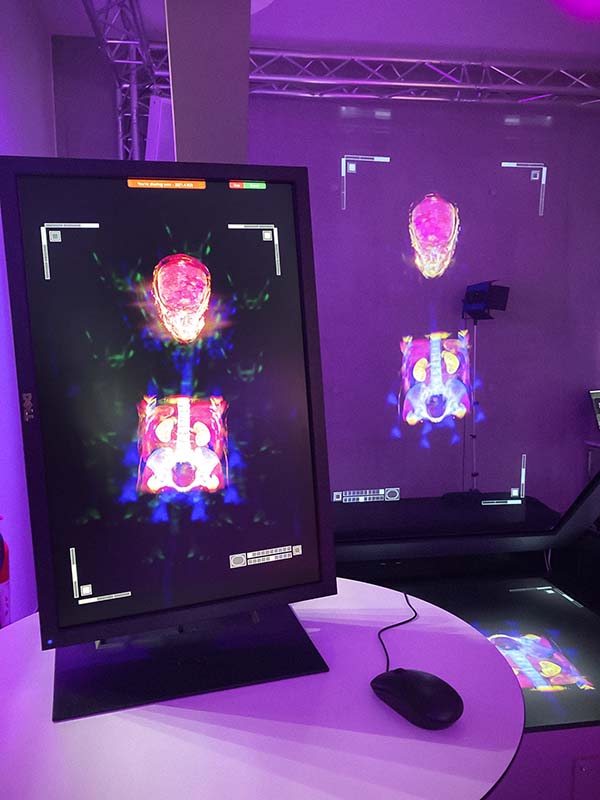
Abstract:
The bodies of ourselves and others are most often considered through their visual surface components. The interior is typically regarded when felt within the self and rarely in regards to others. While radiological tools have dramatically improved our ability for non-invasive representation, their use is regrettably most often confined to the domain of health concerns. This work seeks to instead uncover the possibilities they represent to show the full scope of our bodily form, while obfuscating the accustomed boundary layer – thus removing tells associated with race and in some cases gender as well. Extending this dissolution of perceived identity, it excavates our inner sameness through algorithmically merging bodily interiors into 3d human chimeras beyond the possibilities of mendelian genetics. Through the collection of simple biometrics of participants, hybrid avatars are constructed from real patient data – extending beyond the surface manifold commonly regarded as the self in both physical and virtual worlds.
Machine Learning & Radiology:
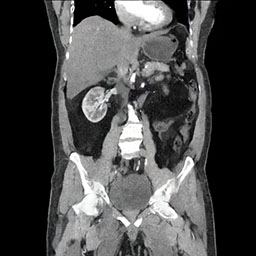
Within radiology there is a large and growing body of research in the potential uses of machine learning. Among these is algorithmic training to improve the visual output quality – allowing low-dose CT imaging to minimize radiation risk, tissue differentiation, and automated identification of pathologies that might be missed by manual review, while also allowing a increased patient reviews. While these are all exciting avenues for research, care must be taken, as with all trained models, to be aware of biases and errors in the training sets, lest current misunderstanding and error become ingrained into future diagnosis.2,3

Research:
This project explored a novel cross-use of motion-based frame interpolation to construct the new chimeras on a layer-by-layer basis. While these techniques expects motion from training on video, the progression of lateral slices produces something not greatly dissimilar from temporal motion. Existing CT interpolations methods were unsuited to the needs of this project for reasons including that they interpolate spatially, not between two sources and the available data was not appropriately formatted for those algorithms. The results from this cross-use are visibly still very much human, although with some artifacting as discussed below.
Methods:
Data sets were selected primarily for visual quality, and those either with control sets or sets lacking obvious visual pathologies. From these, samples were selected, converted into image sequences of layered slices and luminance normalized. Image sequences were manually aligned per-pairing. At each layer in the sequence a merged interpolation of the two frames was produced1 and new sequences from these inter-frames constructed.
Additionally, combined data was used in combination with segmentation software to extract models of individual organs to produce 3d prints (flexible resin). These include a brain composed of two subjects - 19yo female, and 65yo male, a heart composed of one male and one female subject (no further data), and a voice box composed of three individuals (no data).
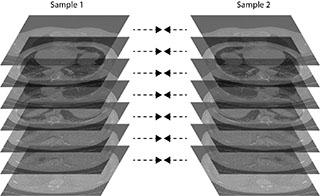
Data Sources6:
These constructions were made of each of three body sections – the head, chest, and abdomen[6a,6b,6c]. Each of these sections was produced by it’s own data source of different individual. For the present version, each section allow 3x3 pairings for a 729 possible chimeric individuals.
Discussion:

The present workflow produces a number of visual tearing artifacts. This is produced as a result of mismatches between bodies and the layer by layer merger approach. Head samples were particularly vulnerable due to significant variance in tilt and rotation of the heads during scanning. Thus they were aligned by the center of the eyes resulting in the lower jaw fragmenting a great deal due to these variations. Reflected glare of metal tooth fillings further exacerbated this issue. Inasmuch as this is an artistic exploration and creative endeavor, the visual artifacts produce a more compelling result by preventing the output from looking too medical, while maintaining a semi-familiar reference.
Further Explorations:
It is expected that significantly improved results might be obtained by training the interpolation algorithm on the intended data. While several voxel-space 3d and 4d algorithms exist to produce super-resolution representations of radiological data, none of them are designed in a manner that might merge two samples. For data sets where segmentation data is available, this may be useful to both improve the quality of interpolation as well as aid in potential production of meshed (rather than voxel) 3d models for physical reproduction.
Exhibited
Ars Electronica, AT. 2022
Tokyo Private, JP. 2022
ESCH2022 : AI & Art, Lux. 2022
Digital Nature Group & xDiversity at Miraikan, JP. 2022
xCoAx, DE. 2023
Screened
[As Corpora in Five Forms]
Ars Electronica Animation Festival, AT/EU 2024
Equilibrio Festival, IT
Publication
Upcoming - Technical and theoretical underpinnings to be published and presented in Expanded 2025, Conference on Animation and Interactive Art. Linz, 2025
ACM Siggraph Asia 2023 Art Gallery
Proceeds of xCoAx 2023, p.331-338
1 Fitsum Reda F, Kontkanen J, Tabellion E, Sun D, Pantofaru C, Curless B. Tensorflow 2 Implementation of "FILM: Frame Interpolation for Large Motion". GitHub, GitHub Repository, 2022, https://github.com/google-research/frame-interpolation
2 Tang, Xiaoli. “The role of artificial intelligence in medical imaging research.” BJR open vol. 2,1 20190031. 28 Nov. 2019, doi:10.1259/bjro.20190031
3 Pesapane, Filippo et al. “Artificial intelligence in medical imaging: threat or opportunity? Radiologists again at the forefront of innovation in medicine.” European radiology experimental vol. 2,1 35. 24 Oct. 2018, doi:10.1186/s41747-018-0061-6
4 Schaefferkoetter J, Yan J, Moon S, Chan R, Ortega C, Metser U, Berlin A, Veit-Haibach P. Deep learning for whole-body medical image generation. Eur J Nucl Med Mol Imaging. 2021 Nov;48(12):3817-3826. doi: 10.1007/s00259-021-05413-0. Epub 2021 May 22. PMID: 34021779.
5 Banerjee I, Bhimireddy AR, et al. Reading Race: AI Recognizes Patient’s Racial Identity In Medical Images. Arxiv.org. 2021 Jul; https://doi.org/10.48550/arXiv.2107.10356.
6 All data was procured from various sources through the Kaggle collection of open research datasets. Only sets with clear public use licenses were selected. It should be noted, the following citations contain the information as provided for each dataset but are both incomplete and irregular by academic citation standards and should be viewed as such. Any further information may be obtained through direct contacts of data providers through the listed URLs.
A Head: Qure.AI HeadCT: Head CTs and Physician Readings from 500 patients. Provided by Chris Crawford and K Scott Mader. License: CC BY-NC-SA 4.0. https://www.kaggle.com/datasets/crawford/qureai-headcthttps://www.kaggle.com/datasets/crawford/qureai-headct
B Chest: CT Chest Segmentations. https://www.kaggle.com/datasets/polomarco/chest-ct-segmentation. From: Segmentation masks for CT scans from OSIC Pulmonary fibrosis progression Comp., Thuringia, Germany. License: CC0: Public Domain; https://www.kaggle.com/datasets/sandorkonya/ct-lung-heart-trachea-segmentation
C Abdomen: CT KIDNEY DATASET: Normal-Cyst-Tumor and Stone; MD Nazmul Islam & MD Humaion Kabir Mehedi, Dhaka, Bangladesh. License: Public with attribution. https://www.kaggle.com/datasets/nazmul0087/ct-kidney-dataset-normal-cyst-tumor-and-stone
Radiant Flux
Reactive tessalation & light-casted recursions
Radiant Flux has now been installed as part of the permanent collection of Current Space. [Feb. 2024]
About
Radiant Flux is an interactive work exploring interplays of light and surface echoing mirror arrays used by NASA and solar thermal energy. In it, an eight foot disc of 128 independently motorized triangular mirrors respond live to participant motion, detected by 3d depth camera. Reflected shards of color are cast by reactive lights (or projected patterns) onto the surrounding environment merging with an accompanying synergistic soundtrack.
Depth-based video is analyzed to extrapolate the motion of individuals before the piece. These motions are either translated directly into a mirror-as-pixel representation or, when certain types of motion are detected, into specific pre-programed and generative patterns. These are then sent to an Arduino to distribute to the eight controllers boards, each handling sixteen motors.
The audio merges sound recordings of metal, glass and water with sounds derived from NASA recordings of solar wind and RF background signals from space. A pre-produced forty-six minute loop is combined with sounds and ambient layers triggered by the patterns and motion used to control the mirrors.
[soundtrack available on bandcamp]
Exhibited
Artscape, 2019
Brilliant Baltimore, 2019
Gallery 4, 2020
Sacred Geometries
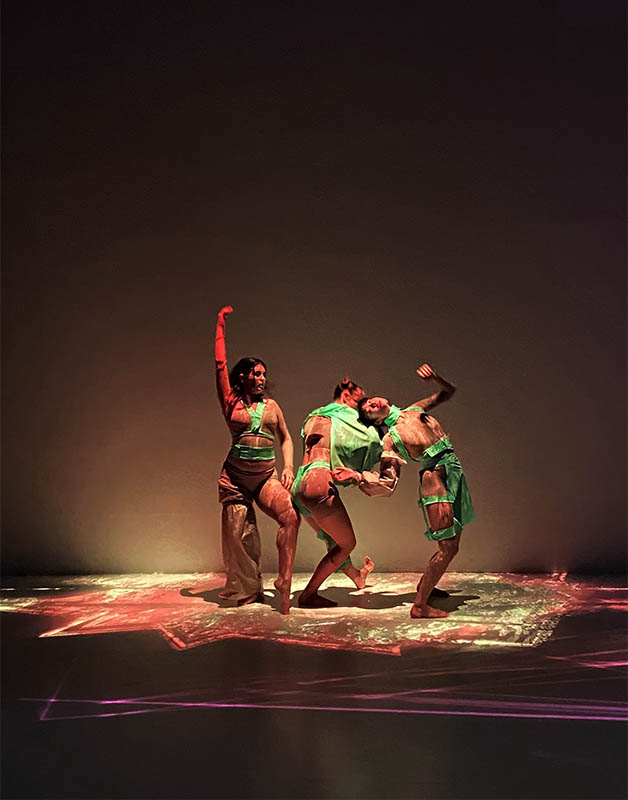
image: Sofia Zeifert
Worn touch and movement trackers are blended with the installed position tracking system of Ars Electronica’s Deep Space 8k to create a dance performance exploring the rituals of human contact and interaction accentuated by visual and auditory components directly influenced by those movements. Geometric forms track the performer while drawing their arcane patterns to the stage, while their motions and contacts translate to excitatory glitches and ambulatory drones.
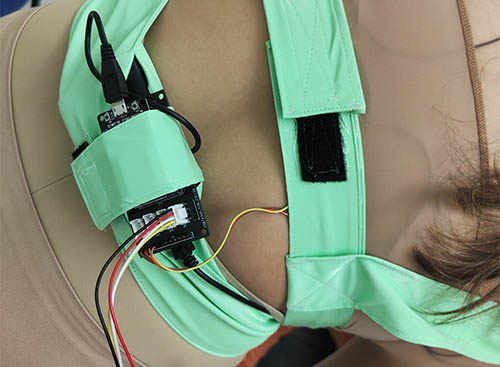
CREDITS
Dance and Movement:
Aitana Ferrández VeracruzNaho Takeda
Aleksandra Georgieva Vucheva
Visual Design
Kevin BlackistoneSensors and Sound
Thomas GeisslFelix Veirlinger
Kevin Blackistone
Costumes & Styling:
Corinna Margarita FaePerformed
Ars Electronica Center. 2024
The Irony Behind Loves Favorite Flower
Produced with Sabah Elhadid
Abstract:
Roses, the symbol of loving devotion, grace many celebrations with their beauty. But they hide a deeper side in exporters like Kenya. Behind their romantic allure lies a stark reality: the environmental strains of cultivation, exacerbated by water scarcity. Moreover, predominantly female workers endure challenging and oft explotative conditions. This juxtaposition challenges roses’ idealized view against complexities extending into issues of sustainability, social justice, and economic impact.
Production:
The work uses died water, heated to melt over time by timescaled import/export data from the cut flowers markets to create an abstract datagram along texture paper used in flower packing. The speed of the paper's progress through the dripping medium is a function of the adoration of the artwork itself, advancing more rapidly as spectators draw near.

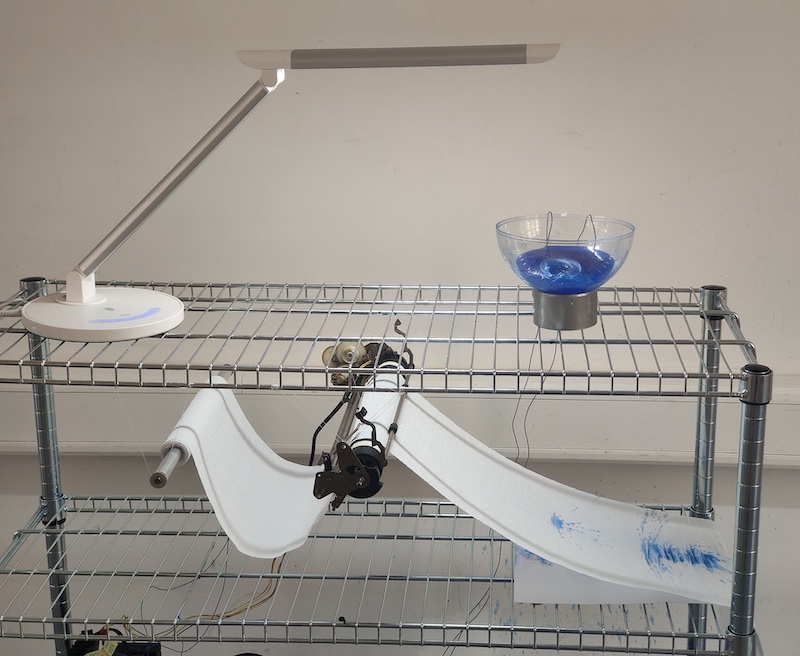

Exhibited
Bauhaus Summaery, DE. 2024
Hyperspectral
with original ambisonic score
About
360° Preliminary Preview Video, use mouse or phone to interact
Exhibited
Speculum Artium, SL. 2022
Mapping Festival, CH 2024
Fulldome Festival, DE. 2024
Microbiospheric Engineering
Proximal automata monitors the growth
drawing attention to the resource extractions of industry on our own planet.

About
Microbiology invokes features of our environment that are often unseen - interacting without our direct intent or involvement, while automation conjures views of large-scale, tightly controlled mass-production. As our technology has progressed, our abilities to manufacture have extended into the micro world, aided by ever more refined industrial machinery. At the same time, these technologies have allowed us to further populate our own world while extracting from it ever greater resources.
Microbiospheric Engineering explores this convergence through a merged visual metaphor, involving human bacterial colonies, their interactions amongst wild-spawning micro-flora, and the automated systems that are used for their surveillance. These concepts manifest through a clear sphere layered with sculpted microbial growth media. Bacterial populations are seeded by personal sampling of select of areas of the skin, monitored by robotically automated microscope and presented as visual landscapes and satellite-style vistas of their expansion upon the sculpted landscape. Each day, further growth appears upon the mountains, valleys and planes of this agar topography. An interior 360° camera provides a periodically updating global world-view, while building a time-lapse of the colonial expansions.
These combined built and spontaneous cartographies provide means to internalize population expansions and resource depletions of our own biosphere, while the proximal automata presenting these unseen worlds draws focus on the approaching micro : macro interactions of mechanical : biological manufacture and our own potential technological limits of growth.
Exhibited
Siggraph Asia, 2021


Self Dissolution
Hybrid beings themselves dissolve through immersive participation in Deep Space.
About


[2m]
sonified diffusion rotary music box

About
[2m] exists as sonifications of spacial relation. A human-distance-based sound sequencer. Each radar-styled radial distance sensor generates it’s own sonic layer based on the multidimensional positions of those within radius; expressed and expanded into a spatialized sonic field to expand the performer or visitors' physical positions and those of placed objects. A consideration of physical distances, (inter)personal spaces and (hyper)awarenesses there-of.
Read More:On Spatial Relations
Exhibited
Ars Electronica Festival, 2021
Performed
Imaginary Network Topologies, 2021
Frequency Fridays, 2021
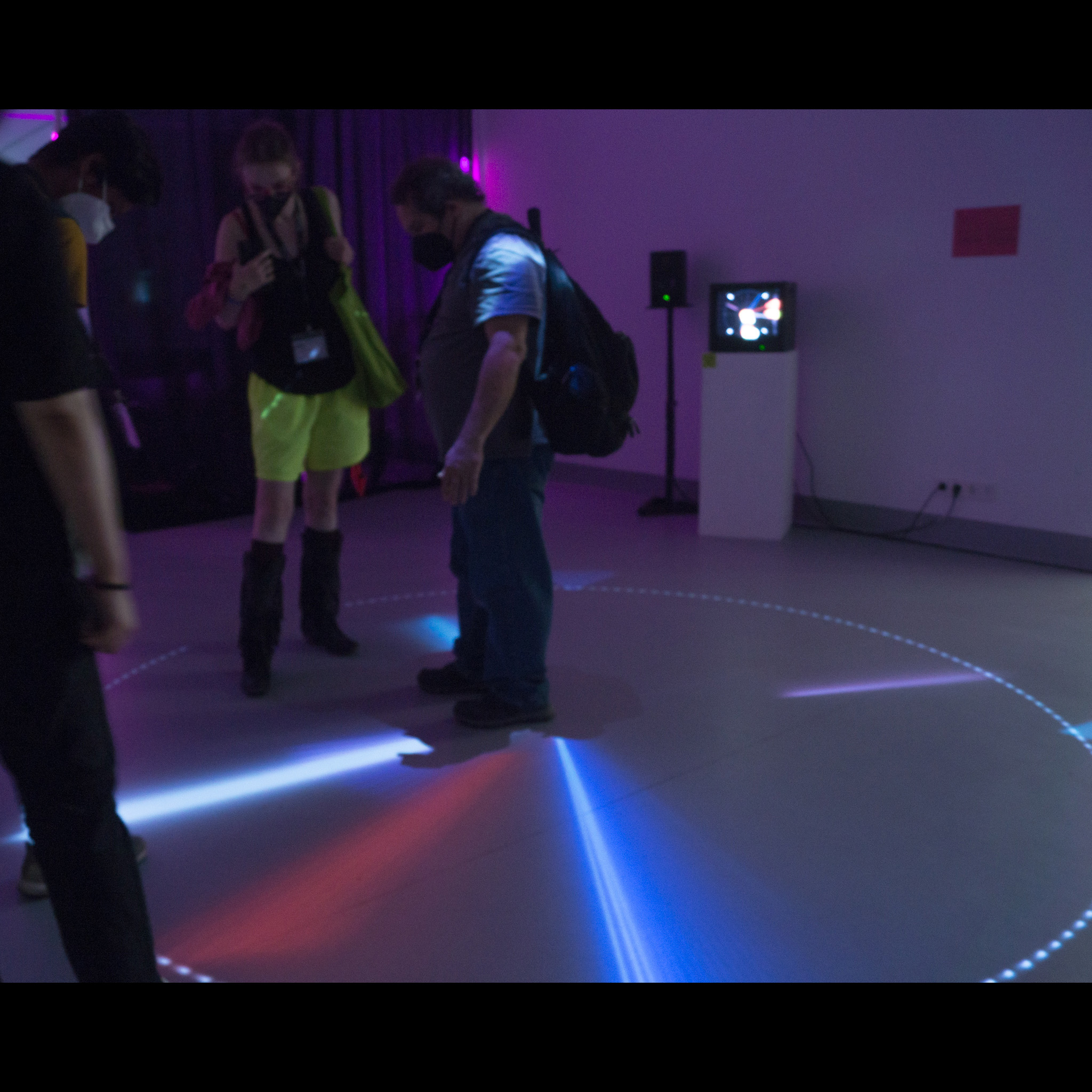

1000 Hungry Eyes
through those whose labors, frequently integral to new developments in technoscience,
are historically and presently ignored and erased.
About
Made in dialogue with Gabriella Garcia
Decoding Stigma
Exhibited
Poetics of Obsolescence, Salzamt, 2022
Arse Elektronic, Ars Electronica Festival, DH5, 2023
2 Danielle Blunt & Zahra Stardust(2021) Automating whorephobia: sex, technology and the violence of deplatforming, Porn Studies, 8:4, 350-366, DOI: 10.1080/23268743.2021.1947883
Zahra Stardust, 2020, What can tech learn from sex workers? Sexual Ethics, Tech Design & Decoding Stigma, https://medium.com/berkman-klein-center/what-can-tech-learn-from-sex-workers-8e0100f0b4b
3 https://thebaffler.com/salvos/no-sex-for-you-gold
4 Baudelaire writes,“a thousand hungry eyes...bending over the peep-holes of the stereoscope, as though they were attic-windows of the infinite.”(1859)
5 https://hackinghustling.org/
Spectral Lines
Inspired by an actaul dream
About
Davis Planetarium, April 2017
Extensions of the Self
through virtual reality headsets; moving and interacting,
while seeing themselves from the perspective of the other.
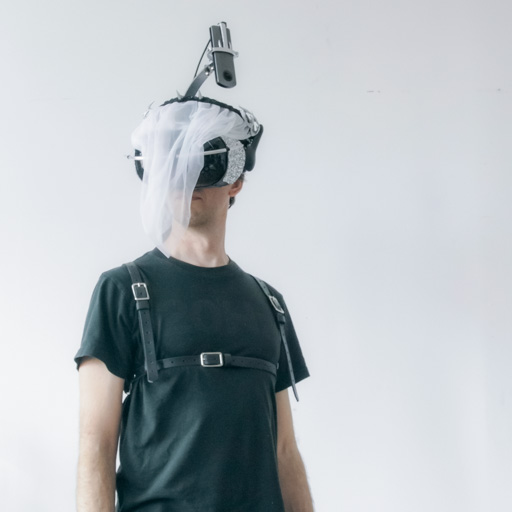
Synopsis:
An exploration of transpositional reality which finds participants wearing virtual reality headsets moving about and interacting, while seeing themselves from the perspective of the other.Description:
It has been often suggested that the present use of digital media as a communications tool unfortunately leaves us less capable of interpersonal understanding. In Extensions of the Self I explore existence within this digital realm by using virtual reality to present to participants a view of their immersed selves through each others eyes.The piece shall consists of two virtual reality headsets and two live-streaming panoramic VR cameras. Each of two current, active individuals wears an apparatus consisting of one of each. The live stream from each camera is processed and sent directly to the headset of the other user. In this way, each party sees what they look like from the other’s perspective. Their motions directly affect the perspective the other sees them through producing the disorientation of seeing yourself only from the perspective of another and provides a visual analogue to the discordant nature of digital interaction in which, frequently, neither side sees the other and never are able to see how they are perceived by the other. This piece will offer individuals an opportunity to explore body motion through each others eyes - with the possibility that they extend this through attempts at physical contact.
Given the wholly individual experiences granted to the two active participants, remaining occupants will be drawn into the space of their realities through on-wall projections of each feed. This adds another layer to those immersed in which they see this secondary representation of their view and the audience response provoked from within their isolated environments. This piece provides a deeper understanding of human interaction and connection through the unique explorations of one’s own externalities.
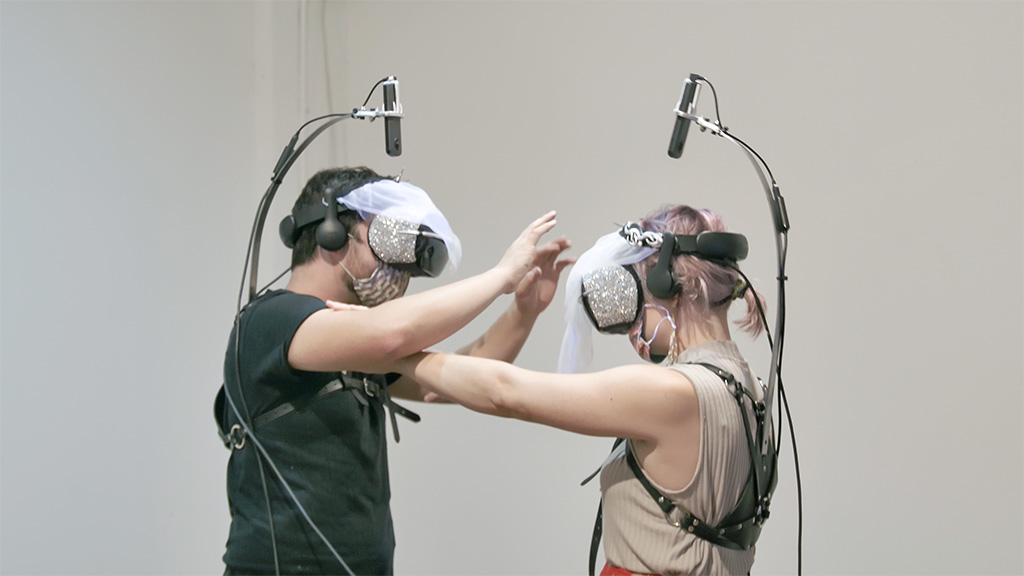

Tangiballs - Sherical Looper
About
Explorations in recording and playback on magnetic medium in spherical topology. This devices allows a more tangible yet randomized approach to the concept of the delay or looper. By recording audio to a spherical surface, one can not only create linear time-loops but scrub between different times of the recording simultaneously. Additionally, the physical interaction of the performer moving the balls back and forth and around can create non-linear circles, circuits and spirals of sound not traditionally possible.
This project is being developed in two permutations:
1.A heavy roll-ball is coated in magnetic recording medium works with an array of physical tape record an play heads. [pictured below]
2.A digital board is used to create a simulation of the same [pictured above], but with additional possibilities and alternative sound artifacts that result from the digital algorithms.
Information published about the production in: A Spherical Tape Topology for Non-linear Audio Looping in New Interfaces for Musical Expression, (NIME2025)
Github repository here.
An updated device is not in production to improve control as well as allow incorporation into modular setups.
In Production
Two Dial Continuous Controller
About
The Soft Pink Truth - Multinationelle Mordare
Impacts of Globalization and Supply Chain Economics
Album available HERE
043714
Sounds influence image influences sounds
Installation
Farley Arts Gallery
Art Week MX Pop-up, CDMX
Baltimore Museum of Art, Screening Room
Screenings
The Red Room Collective
New Works, Baltimore, US
The Parkway Theater
Convergence Maximus
@ Light City
Orchestra, opera, architecture, abstract literalism
Architectural mappings designed to accompany music produced through collaboration of concert performers and DIY composers/instrumentation.
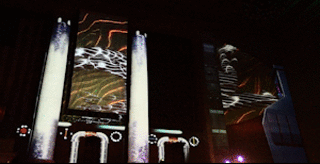

Who's Watching
often times both.
About
Participants in two spaces are surrounded by projections of those in the other while opening themselves to further data collection and biometric cataloguing.
Details at: On Surveillance
flatland
Dimension, colonialism, exploration, quantum mechanics
an immersive installation and performative adaptation and expansion of the original text by Edwin A. Abott.
Watch Full
[TRT:01:44:51]
Icosohedral Interfacing
An icosohedron moves through it
Installation
Farley Arts Gallery
Art Week MX Pop-up, CDMX
Baltimore Museum of Art - Screening Room Series
Screening
Sweaty Eyeballs Animation Festival 2020
Imagined Devices
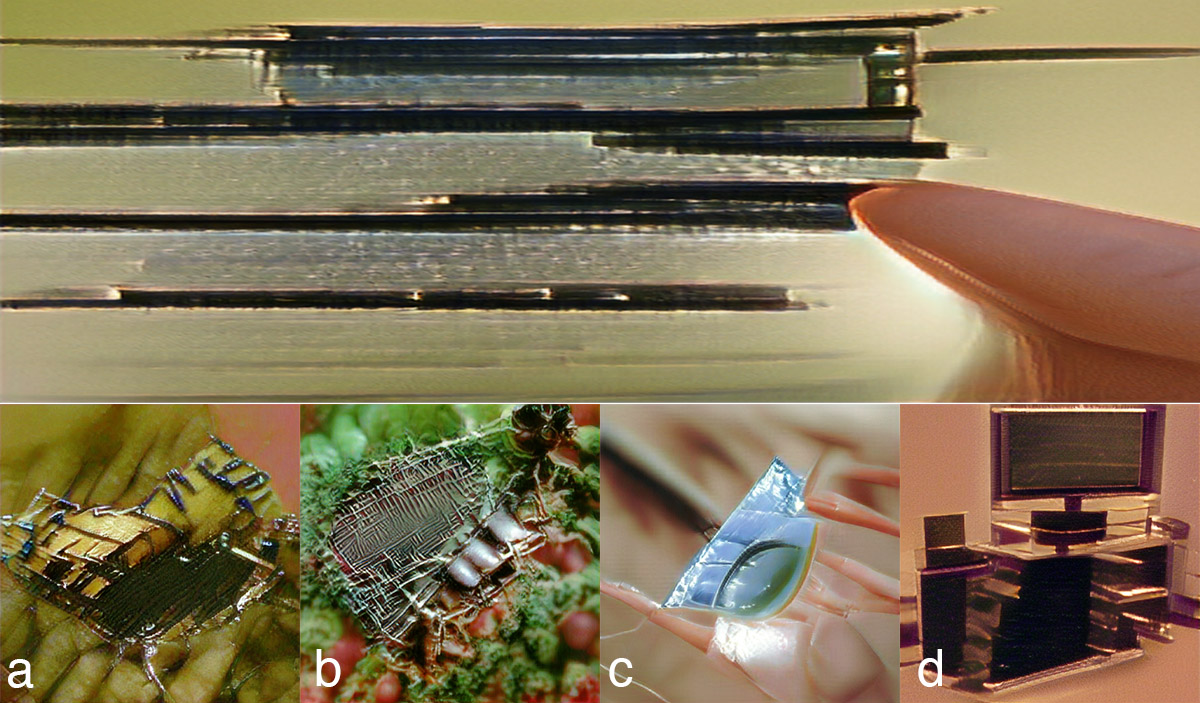
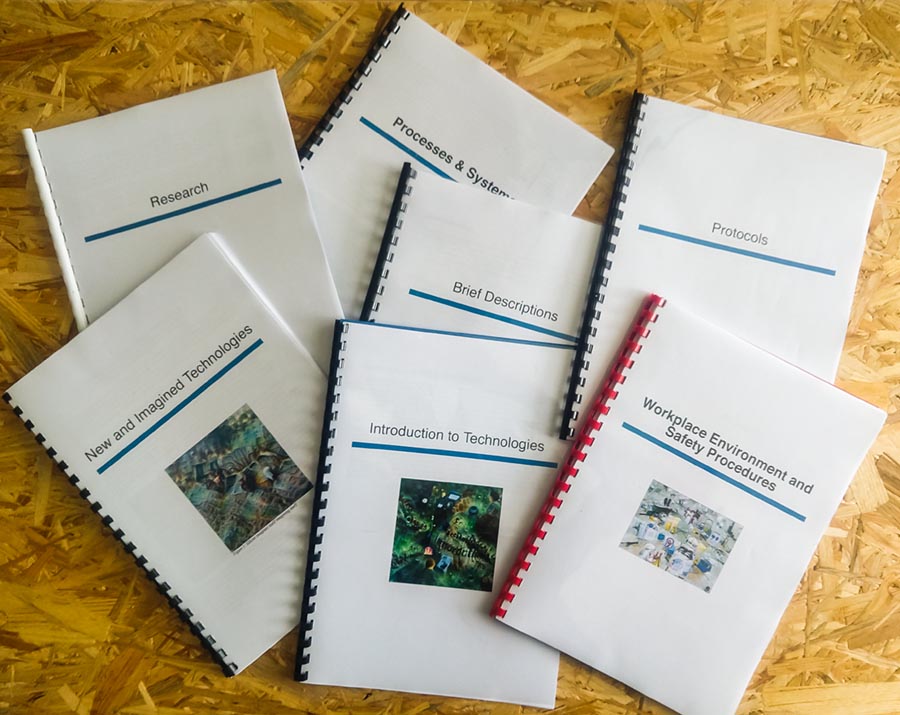

Machine-learning produced documents provide a machine's-eyed imagination of their own creation in text documents and imagined figures
Made in affiliation with the ENAS Fraunhofer Institute for display at Ars Electronica
More
Exhibited
Ars Electronica Center, 2021
ENAS Fraunhofer Institute, 2021
Smoke Bellow - Blooming 1
Literal, abstract, interpretation
Music: Smoke Bellow
Broadcast
Rage TV, Australia
Flashbacks [memory lapse]
permanence & retention | memory & sentiment | one's computer's every image | a cross-section of an existence
Screening
Volumes Art Fair; Zürich, CH]
Installation
Videopolis; Baltimore, US
Friction_ track1; Zürich, CH
Grindwheel
About
A warm distant touch
About
The warmth of one hand is wirelessly transmitted to allow a distant other. Documentation in development.phases in architecture
About
Accoustics & Architecture
Weather
Layered satellite data
emergent form & flow
atmosphere & turbulence
GOES East:
visible, infrared & water vapor
Screening
Volumes Art Fair; Zürich, CH
Barbarella's; Daegu, SK
Videopolis; Baltimore, US
Installation
Friction_ Track1; Zürich, CH
Transforms Lexington
Constructive meditations on deconstructive contemporary replacement
Installation
Baltimore Museum of Art - Screening Room Series
Intersections
merging : diverging paths from two cities
In the Stacks
Feature music by
Architectural mapping of the George Peabody library with experiment chamber musician Mind On Fire and music by composer Cat Lamb.
Dec. 2019.
Website: In The Stacks
preliminary documentation
Invalid Corpus
About
A diffused accoustic soundscape in 9 channel sound (8 channel surround with a central down oriented speaker) using Mozilla's CV_Corpus voice training data set of invalid voice samples to produce the experience of hearing the unintelligible thoughts of a room full of moving people. To accompany this piece a video text of the presumed statements scrolls on a screen. Half of the audience is oriented to towards and half away from this video. This divides the experience into those trying to make sense of several voices by audio alone and those trying to do so with a dissonance of several lines of incorrectly indentified text.
Aparat - LP5 planetarium show
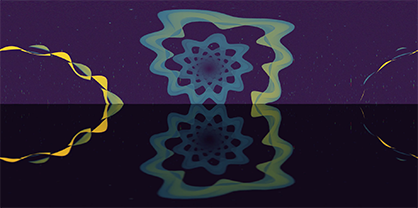
Lead Animator:
Daniel Givens
Album length planetarium show produced for the release of LP5 and shown at the Zeiss-Großplanetarium in Berlin. Converted for VR.
VR Experience Playlist
Apparat LP5
Available on Mute Records
A luminance within
human movements within the skin
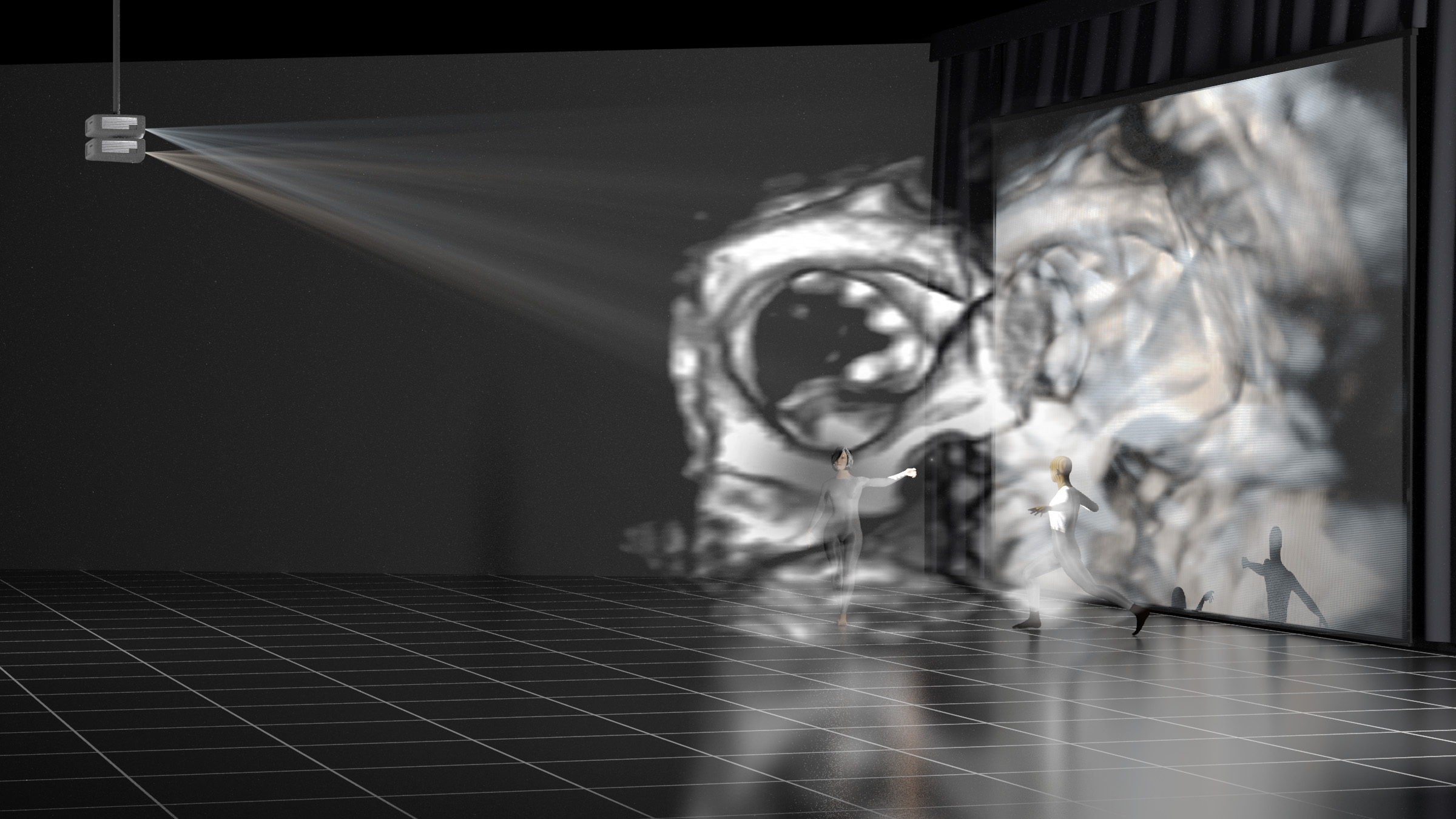
Movement performers are enveloped in a 3d projected model of their internal organs, generated through live ultrasound scans of their bodies.
Reading:
Transpositional Reality
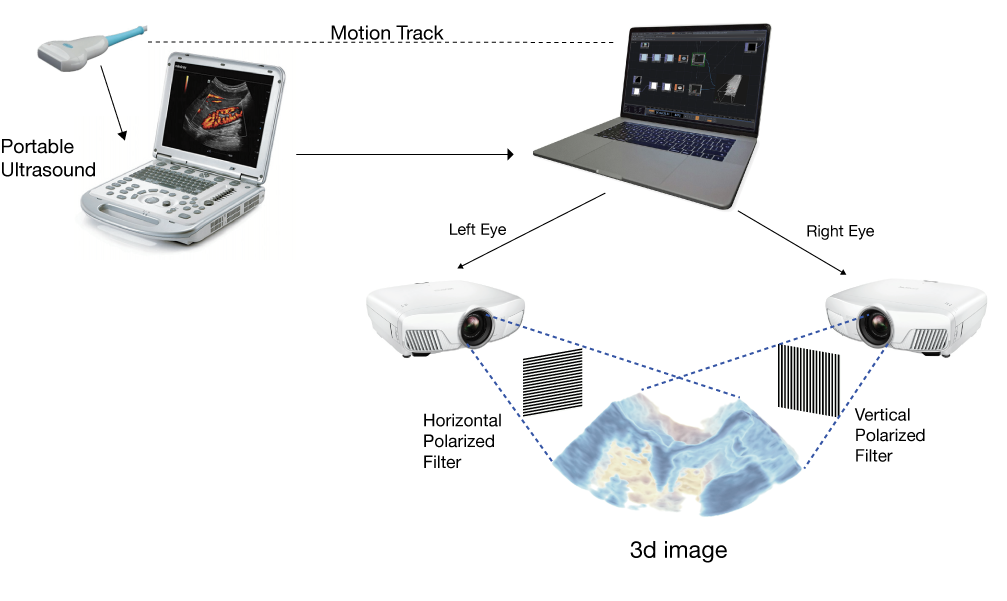
Primate Methylation
Project: Attempt auditory comparative analysis of DNA Methylation & RNA Expression Data
Design: RNA-Seq WIG files are fed into PureData after adjustments to fill no-coverage base pair locations.
Per base per sample coverage used as waveform, FM Modulator and AM Modulator [as described below sample audio tracks].
Samples merged to left (4x MR samples) and right (4x PR Samples) channels.
Variation between left and right could denote regions of interest for further exploration.
Result: No sufficiently perceptible occurrence was found.
Further exploration is needed to determine if this concept has any utility beyond the artistic.
Sample Patch [Visual]:
|
Sample 1
Sample 2
Sample 3 |
New Memphis

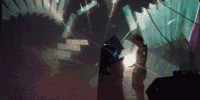
About
Visualization of a dystopian far future. An isolated city where energy-based wealth is centralized. 3d projected background designs for the Electric Pharaoh; producted by the Baltimore Rock Opera Societymore.
Performance:
Baltimore, US
Washington DC, US
Philadelphia, US
Overture
Node Synth

About
An additive synth built by placing nodes. Frequencies are determined by distance relations. Maximum and minimum distance settings act as high and low pass filters in this way. Four blended waveforms and (currently) up to ten voices per allows significant tonal control. Multiple controls available can be sequenced through two step sequencers. All functionality it still very developmental as this was intended as a quick test project that ballooned.
Features: ADSR, Randomizer, 2 step sequencers, our oscillator blend, drone v note, node positional randomizer, distance cutoffs
Oracle's Gate

About
An archway of luminous fibers & melodic ambient waves of music support an immense digital face [‘Oracle’] watching and speaking. Beyond, a dramatically lit ‘floating’ platform [‘Temple’] draws visitors into an opportunity to control the oracle. In the temple they view a POV of those beneath the gate. Movements of their head, mouth and eyes are translated to the avatar as a microphone feeds their spoken prophecy through an audio processor to scramble it to a melodic unintelligibility.


Ouijkeyboard
About
The talking board method of divination has existed and evolved over many centuries eventually into the best known western example of the Ouijaboard as designed in late 19th century Baltimore. This project expands the idea by merging it with the concepts of the most common peripheral interfaces to the computer, those of the keyboard and mouse. Rather than the deterministic and intentional use of those, this blends the unpridictability of the Ouija's influences, whether spiritual or musculo, and adds a layer of statistical prediction. Rather than type the letter the planchette (mouse) falls most upon, it selects the characters it thinks are most likely based on input texts of Baudelaire, John Dee, and a research analysis of emojis. Eschewing the popular use of machine learning, it rather uses a simpler markov model base on singlet, double and triple letter likelyhoods to make its predictions.
Persistance of Vision
About
a companion piece to who's watching referencing the Baltimore's secret spy plane program brought by 'Persistent Surveillance Systems'
Installation
Mercury Theater, Baltimore
More Reading: On Surveillance
Plinkomposer
A simple randomized sequencer based on the popular game. Layers of pins play in modal scales.
Speaker Array
Design: Custom speaker housing was designed using basic hardware and reclaimed materials.
Cabinets each contained one two-way 165mm 4Ω speaker.
Dense cardboard form-tubes were selected for basic cabinet both for simplicity of material and acoustic properties
Acoustic batting to minimize case design frequencies was made using a combination of dense fiberglass duct liner and loose insulation fiberglass
End caps and mounting were custom CNC cut to flush fit from 9.5mm (3/8") plywood
Speaker routing was done using high gauge wire (for length) and a combination of parallel and series circuits to produce a 6Ω line impedance at the amp.
|
Speaker Design:
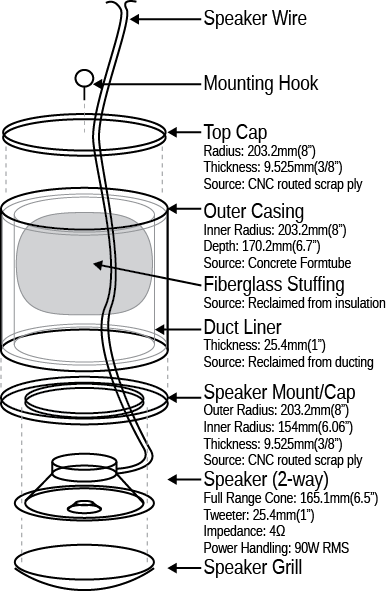
|
Circuit Layout:
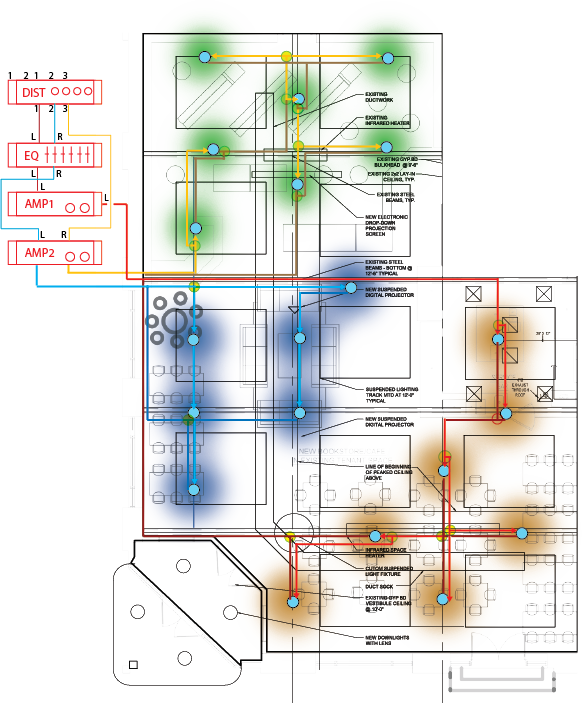
|
Timecode

evolving generated abstractions play with the subject of time as the common timecode bars are filtered, abstracted and blended through an array of generative automatic processes to create an ever shifting visual field not just over time, but of and from time's representation in video and film production.
abbreviated demo of vertical installation
TRT: 1h loop
Installation
Farley Arts Gallery
Art Week MX Pop-up, Mexico City
The Metro Gallery: Yearbook; Baltimore
Gallery 4, Baltimore
Universal Content
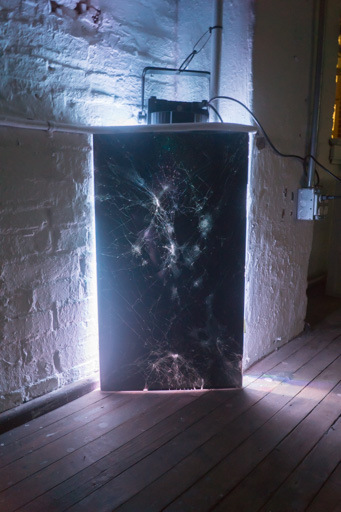
Galactic formations from the cracks in a screen reflect on shrinking interactions with the universe in existence beyond it's borders.
Serve Yourself
Guests dine at a table mapped with geometric forms and manipulated video of themselves
Birds
flocking
collecting
continuing
Installation
Videopolis; Baltimore, US
Pedagogy
underground
[16mm : film]
Screening
Volumes Art Fair; Zürich, CH
Barbarella's; Daegu, SK
Videopolis; Baltimore, US
UMBC; Baltimore, US
Urban Fragementation
Crystaline forms on urban detritus
Installation
Janet & Walter Sondheim Semifinalist Exhibition 2018; Baltimore, US
Read More: On Aging Structures
Motion || Dissolution
About
Only constant interaction gives form and connection. Momentary rest only dissolves the digital self. An visualization of the drive to constantly update, produce, and document ones existence within the digital realms to maintain ones identity to others.
Digital Cascade
Interactive installation
surveillance vs. privacy
flashing images of showering individuals, digitally destroyed
[TRT: 33:45]
Incel Insel
About
A humorous exploration of the zeitgheist of the incel. A lone player makes their way through a dark island landscape of lightbulbs and red pills. with the collection of each the landscape becomes more or less clear as the water line grows or recedes. Through one path, the player becomes reaches the peak on their own very small island, through the other they find their way out of their parent's basement.Your and idiot!
About
Combining metadata from search results, individual terms are collected and show the definitions on image thumbnails used by the back-end of search engines to determine expected intent.Celestial I & II

Video/Audio reactive projections exploring celestial bodies accompanied by string quartet
Installation
GUISE at Maryland Art Place; Baltimore, US




